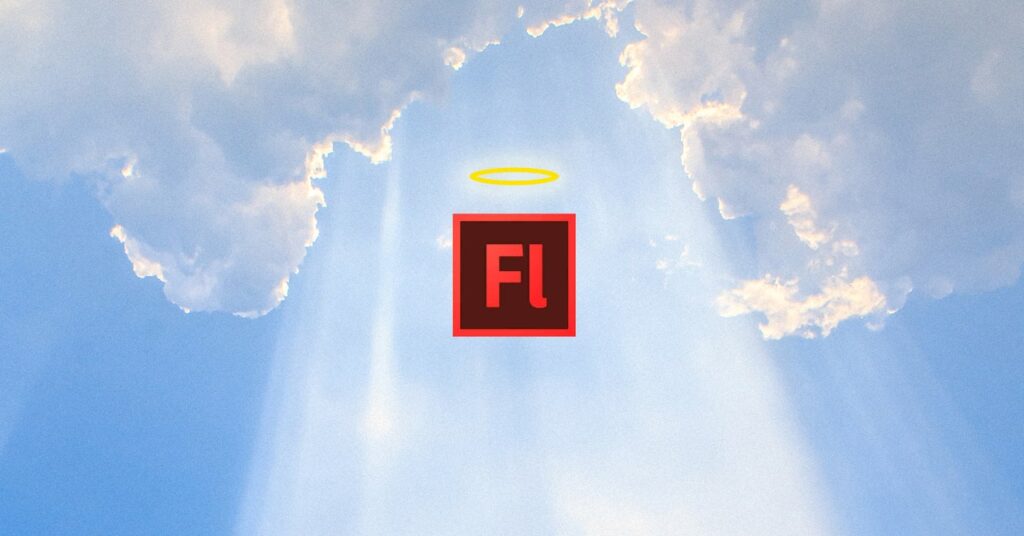A Farewell to Adobe Flash—and the Messy, Glorious Web
The software helped create an amateur internet. It’s a far cry from the glossy, corporate one we know now….


My earliest memory of Flash was that it got me into trouble. I had heard about a website that hosted brutal games, including one particularly difficult shooter starring an audacious yellow alien. I soon discovered that this site, Newgrounds.com, brimmed with warped takes on American culture—within minutes, I had battered Osama bin Laden and chain-sawed my way through a string of office colleagues. The next day, I visited the site at a friend’s house, and we massacred a school. In the evening, his mum rang mine to ask why her son had been undressing Britney Spears.
On December 31, Flash died. Adobe stopped updates and now recommends you uninstall it. This end has been a long time coming—since June 2017, officially; unofficially, since April 2010, when Apple’s Steve Jobs announced that Flash would not run on the iPhone. Its legacy lives on in Adult Swim cartoons and zany mobile games. Toiling conservationists continue to convert and archive old Flash content before it is lost forever.
Flash’s death is, in many ways, incidental—there may even be an impulse to welcome it. For those of a certain age, the command “Please install Flash Player” still provokes a tinge of irritation, as they remember how it came between them and that bopping badger video. But the software’s end is also a synecdoche of an aesthetic project years in the making. It’s a reminder of how the web has been cleaned up; how it has been transformed from a messy and amateur space into a glossy and corporate one.
Flash animations could be crude and childish; they could be profane and pornographic. They were politically incorrect, an ideology that sometimes bled into real life—the creator of Stick Assault is now a racist YouTuber. One member of Newgrounds posted two cartoons—“Clown” and “Target Practice”—before shooting up his school.
But these are isolated examples among a generally harmless chaos. If there was a small share of depravity, it’s because Flash was so easy to use. What would have taken a studio of animators months to draw could be produced in just a few days, as Flash algorithmically generated the images between two keyframes. This led to its iconic lilting movement—“motion without cycles,” in the technical jargon—accompanied by the thick black outlines required to endure the poor resolutions of computer monitors.
The most memorable of these creations came from David Firth. Where Newgrounds was unquestionably American, Fat-Pie, Firth’s website, was intrinsically British. Salad Fingers, the creepy green humanoid with spinning digits, is his most famous character, but I watched every one of his night-terror creations, from eloquent locusts to mass-murdering milkmen to Burnt Face Man, the inept superhero who claimed that “crime is a shit that needs cleaning up.” His cartoons, often paired with music from Aphex Twin, obliquely reflected British society—Chris Morris’ satire without the politics. In the early 2000s, they looked how I felt.
The best animation, argues the film critic Richard Brody, captures “the spontaneity, the free-flowing imagination, and the uninhibited sense of fun at the heart of the medium.” Flash spread these instincts across the web. The worst Flash websites were a thing to behold—remember restaurant sites with pumping muzak and flying food? There seemed no one framework back then.
In this sense, Flash was a bridge between generations. Its creator, Jonathan Gay, explained that the web could have settled on a filmic experience, based on movies and television, rather than the textual Twittersphere we accept now. Flash facilitated the personalization associated with Web 1.0 relics like Geocities, with users encouraged to manually “code, design, and manage” their website, in the words of architecture critic Kate Wagner, a state of affairs replaced by the corporate, professionally designed web that we cannot customize but must experience. This new professional web is glossy, uniform, and minimalist, typified by app stores, smartphones, and Facebook. Participatory “portal” culture, which websites like Newgrounds kicked off, is supercharged, but personalization is destroyed.




